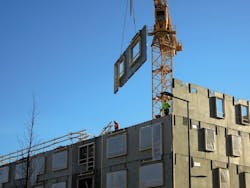Contractor Giants are all in on offsite construction
By David Barista, Editorial Director
The complete findings from our inaugural Giants 300 Technology and Innovation Study will be available soon at BDCnetwork.com/2019TechSurvey. This 12-question survey was emailed to all 486 firms that participated in BD+C’s 2019 Giants 300 Report; 130 firms completed the tech survey, for a participation rate of 26.7%.
The objective of the study was to gain a deeper understanding of the state of AEC technology adoption and innovation initiatives at the nation’s largest architecture, engineering, and construction firms. There are dozens of takeaways from this study, including which tech tools are being used most frequently, and which tools offer the best ROI (see our recap on page 40).
One takeaway that stood out for me was the astonishingly high adoption rate of offsite construction among the general contractors and construction management firms. Of the 35 GCs and CMs that participated in the survey, 25 firms (71.4%) indicated that they use offsite/prefab construction on projects, and, incredibly, nearly half (45.7%, or 16 firms) use offsite construction on “all” or “many” projects.
Of the 10 firms that currently are not implementing offsite construction on projects, three firms are pilot-testing offsite processes and four are considering the approach for future application. That leaves just three firms (8.5%) that indicated they have zero interest in offsite construction—which means we’re looking at an adoption rate of more than 90% among the nation’s largest GCs and CMs.
When asked to pinpoint the single most significant AEC technology innovation their firm has initiated in the past year with positive results, DPR Construction’s National Director of Innovation, Kaushal Diwan, cited the use of multitrade/multiscope prefabrication through its strategic partnership with Phoenix-based prefab provider Digital Building Components: “The ability to take more complex work offsite while other work proceeds, then bring ready-to-install elements to the site is a significant advance in the use of prefabrication. With the existing labor shortage and desire to still have speed-to-market, we think we’re only beginning to see the possibilities.”
Speed, quality, advanced coordination, and schedule gains are commonly cited as benefits of offsite construction. But what about hard-dollar ROI?
“Our current metrics savings show that prefabricating with Digital Building Components offsite saves 10–20% on overall cost,” said Diwan. “It can save time by improving installation efficiency by 20–30%, and it increases quality by reducing rework to less than 1%.”
The caveat, added Diwan, is that these results “are only possible through deep adoption and integration with virtual design and construction and robotics technology, which Digital Building Components uses.”
